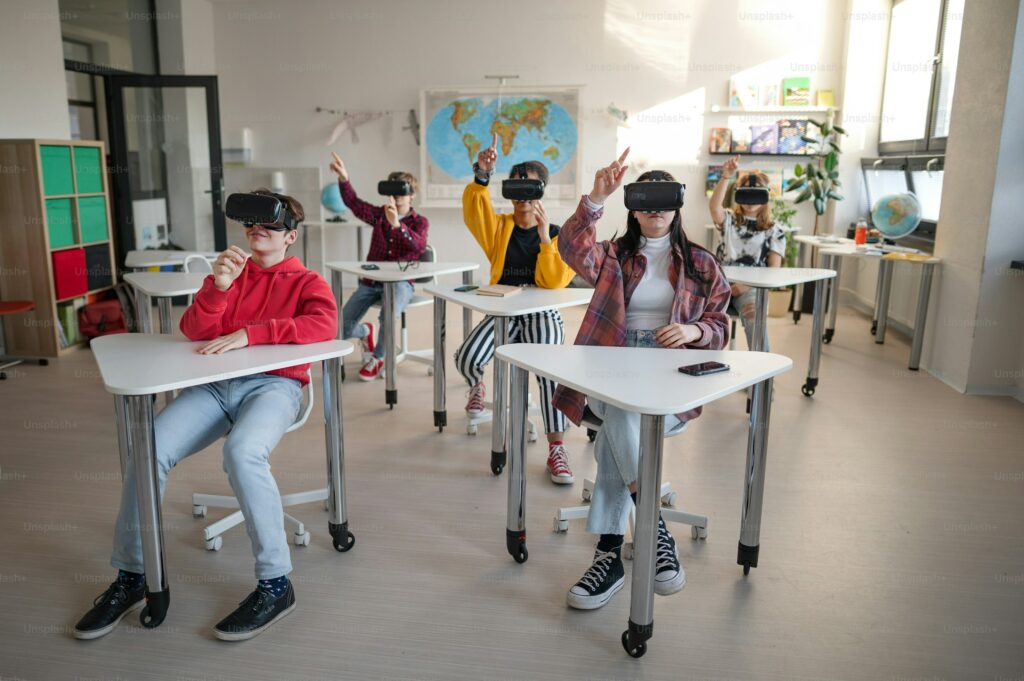Blog Post #5
Predictive Technologies and AI in Education
Predictive technologies, particularly artificial intelligence (AI), are reshaping education by introducing tools that utilize predictive analytics to enhance teaching and learning processes. These innovations enable personalized learning experiences, streamline educational management, and optimize instructional practices.
Some examples of AI tools used in education include:
| AI tools | Description | Example |
| Intelligent tutoring systems (ITS) | These systems use historical student data to personalize learning by identifying a student’s “learning edge” and tailoring questions or activities accordingly. | Machine learning-based ITS systems
|
| Assessment and feedback | AI-based assessment systems analyze student interactions on digital learning platforms to infer knowledge states. They also automating the evaluation of attributes like grammar, spelling, and vocabulary in writing submissions, while also offering insights into more complex elements such as rhetorical structures. | Grammarly – a grammar-checking tool that offers suggestions for improving wording and sentence structure.
|
| Coaching and counselling
| AI tools help to automate some tasks of coaches and counsellors in schools and to improve interactions between students and counsellors
| AI chatbot for student support |
AI-powered systems analyze data and identify patterns to adapt to the unique needs of each student, creating a more personalized and efficient learning experience. By automating repetitive tasks, AI allows human educators to dedicate more time to addressing complex or sensitive student concerns, enhancing overall efficiency.
Benefits of AI in Education
AI in education presents numerous benefits that can significantly enhance both learning and teaching, including personalized learning experiences, automation of administrative tasks, and the creation of adaptive learning environments.
AI can provide highly personalized learning experiences tailored to individual students’ needs, strengths, and weaknesses. By analyzing data from student interactions with learning materials, AI algorithms can identify learning patterns and adjust the content accordingly, ensuring that each student progresses at their own pace. Additionally, AI can automate repetitive administrative tasks, such as grading, attendance tracking, and scheduling, allowing educators to devote more time to direct teaching and student interaction. Moreover, AI can generate dynamic and adaptive learning environments that adjust to students’ real-time performance. It can also help design learning activities that focus on the areas where a student is struggling, enabling educators to identify students who may require additional support. Platforms like adaptive quizzes or chatbots can identify and address gaps in knowledge, enhancing engagement and understanding.

Challenges of AI in Education
Despite the benefits, several challenges hinder the adoption of AI in education.
One of the most significant barriers to the adoption of AI in education is cost. Advanced AI systems can be prohibitively expensive to implement and maintain, with ongoing expenses for updates, technical support, and infrastructure. Smaller schools and districts, particularly those in rural areas, often lack the financial resources to invest in these technologies, resulting in unequal access to educational tools. In addition to financial constraints, the “black box” nature of AI poses another challenge. The decision-making processes of many AI systems are not transparent, making it difficult for educators to understand how conclusions are reached. This lack of transparency can lead to mistrust, as teachers may question the accuracy or fairness of AI-driven recommendations and decisions. Furthermore, if AI systems are trained on biased data, they may inadvertently perpetuate stereotypes or reinforce existing inequities, marginalizing certain groups of students. This could lead to discriminatory outcomes, such as unequal treatment or opportunities, further exacerbating educational disparities.
In the video AI in Education: Opportunities and Challenges, experts explore both the potential and the challenges AI brings to education. While AI promises personalized learning and efficient administrative tasks, it also raises concerns about bias, inequity, and the loss of teacher-student interaction. Over-reliance on AI tools could undermine critical thinking and perpetuate existing educational disparities. The video highlights the need for careful integration of AI, with ethical guidelines to ensure it enhances rather than harms the learning experience
To overcome these obstacles, governments and educational organizations could explore options such as subsidizing AI technologies or offering grants to schools in need. It is also crucial to invest in teacher training programs that focus on AI integration, helping educators build confidence in using AI tools and ensuring they can utilize them effectively.
Ethical Considerations of AI in Education
The integration of AI into education raises several important ethical concerns, particularly around data privacy, transparency, and bias. As AI systems increasingly shape learning environments, the need to address these ethical issues becomes more urgent. AI tools often require large volumes of student data to function effectively, which poses significant privacy risks, especially when dealing with minors. It is essential to ensure that this data is securely stored and used responsibly to prevent misuse or unauthorized access.
Another major concern is transparency. Both students and educators must have a clear understanding of how AI algorithms make decisions, particularly in high-stakes contexts like grading or personalized learning. Without transparency, students may lose trust in the system or be unaware of how decisions that affect their education are being made. Bias in AI systems is perhaps one of the most critical ethical issues. AI algorithms, if trained on biased data, can perpetuate or even exacerbate existing inequalities, potentially disadvantaging marginalized groups. This can manifest in various ways, such as offering certain students fewer opportunities or resources based on skewed data patterns.
The video Ethics of AI: Challenges and Governance underscores the widespread lack of understanding among individuals about how AI functions or the reliability of its outputs. It calls for AI governance that prioritizes ethical principles, such as protecting human rights and dignity. Transparent frameworks are essential to promote fairness and accountability as well as to address pressing concerns like data privacy and algorithmic bias. The video also highlights that the societal impact of AI is shaped not by the technology itself but by the frameworks and policies designed by humans to regulate its use.
In educational settings, ensuring the responsible and ethical use of AI requires a robust framework. Educators should establish clear policies and guidelines for students on using AI in their learning. Additionally, teacher training programs focused on AI integration are crucial. These programs can help educators build confidence in using AI tools effectively and responsibly, ensuring they maximize the benefits of AI while addressing potential ethical challenges.
Future Directions in EdTech
The future of educational technology (EdTech) is poised to revolutionize teaching and learning by integrating various emerging technologies.
According to Bouchrika (2024), several key trends are shaping the landscape of education, with artificial intelligence (AI) leading the way. In the coming years, AI will play an increasingly central role in personalizing the educational experience. It will offer tailored feedback for students, automate administrative tasks to reduce teacher workload and enhance both student engagement and instructional effectiveness.
Moreover, technologies such as virtual reality (VR) and augmented reality (AR) are creating immersive, interactive learning environments, especially in disciplines like science, engineering, and medical training. These tools allow students to interact with complex, abstract concepts in a three-dimensional virtual space, significantly enhancing comprehension and engagement. By simulating real-world scenarios, VR/AR not only makes learning more dynamic but also bridges the gap between theory and practice.
I think in the next 5-10 years, these technologies could further transform education by making learning more interactive and experiential. For instance, VR could facilitate virtual lab experiments or allow students to explore historical landmarks, offering a hands-on approach to learning that transcends traditional classroom settings. This shift toward experiential education has the potential to democratize learning by breaking down geographical and financial barriers and making high-quality education more inclusive and globally accessible.

References:
Bailey, J. (2024). AI in education. ProQuest.
Bouchrika, I. (2024). Digital transformation in education: How EdTech is shaping the future of learning. Research.com. https://research.com/software/digital-transformation-in-education-how-ed-tech-is-shaping-the-future-of-learning
Gillani, N., Eynon, R., Chiabaut, C., & Finkel, K. (2023). Unpacking the “Black Box” of AI in Education. Educational Technology & Society, 26(1), 99-111.


